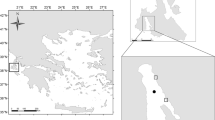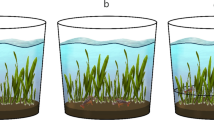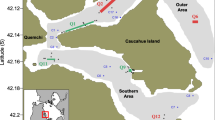Abstract
Over the past three decades, fish net pen culture has been developed in the coastal waters of Japan. However, serious organic pollution of the surrounding water and sediment followed the development of this new style of fishery. This paper reports a typical example of the environmental disturbance that has occurred due to the organic pollution resulting from fish net pen culture. Since fish cultivation was initiated in 1973, oxygen depletion of the bottom water and extremely reducing conditions within the sediment have occurred during the summer. These environmental disturbances resulted in unusual dynamics of the benthic communities including defaunation in the summer and recolonization of the azoic areas from autumn to the next spring. Significant changes in the benthic fauna were observed between benthic communities before and after organic pollution of the sediment. Molluscs were originally the most dominant benthic fauna. As organic pollution of the bottom sediment progressed, the molluscs were replaced by polychaetes. Likewise, total biomass of the benthic fauna decreased markedly over the past two decades. Prior to contamination, the organic matter deposited on the sediment was decomposed by the action of bacteria, ciliates, meiofauna, and macrofauna. The addition of organic material resulting from fish culture has overwhelmed these decomposition mechanisms, and conditions have worsened as organic matter is continuously added to the sediment. Contamination of marine sediment by the net pen cultivation of fish sets up a vicious cycle: the addition of exogenous sources of organic material increases the need for a more vigorous decomposition process while actually creating conditions that limit the rate of the necessary decomposition activity. The sustainable development of fish net pen culture will require the creation of a new technology that efficiently promotes the decomposition of organic matter deposited below the pen nets.
Similar content being viewed by others
Literature Cited
Anker, S. 1977. The soft bottom ecosystem of Northern Baltic proper with special reference to the macrofauna.Contributions from the Asko Laboratory, University of Stockholm, Sweden 19:1–62.
Fishery Experimental Station of Kumamoto Prefecture. (1973–1979). Annual report on the rearing conditions of the fish farms in Kumamoto prefecture.Jigyou Hokokusho 1973–1989.
Grassle, J. F. andJ. P. Grassle. 1974. Opportunistic life histories and genetic systems in marine benthic polychaetes.Journal of Marine Research 32:253–284.
Hata, Y. 1990. Bottom sediments, p. 51–68.In T. Watanabe (ed.), Coastal Fish Farms and the Environment. Kouseisha-Kouseikaku, Tokyo.
Kakino, J., S. Matsumura, Y. Sato, andN. Kase. 1987. Relationship between Aoshio, blue-green turbid water, and winddriven current.Nippon Suisan Gakkaishi 53:1475–1481.
Kikuchi, T. andM. Tanaka. 1976. Some aspects on the ecology of a short-lived semelid bivalve,Theora lata (HINDS), with special reference to its opportunistic life history.Physiology and Ecology, Japan 17:261–271.
Kikuchi, T. andM. Tanaka. 1978. Ecological studies on benthic macrofauna in Tomoe Cove, Amakusa. I. Community structure and seasonal change of biomass.Publications from the Amakusa Marine Biological Laboratory, Kyushu University 4:189–213.
Kubota, T. 1977. Fish net pen culture p. 9–18.In The Japanese Society of Scientific Fisheries (ed.) Fish Culture in Coastal Areas and Self-Pollution (Senkai Yoshoku to Jika Osen). Kouseisha-Kouseikaku, Tokyo.
Kusuda, R. 1977. Damage of cultured fish due to infection of diseases, p. 77–86.In The Japanese Society of Scientific Fisheries (ed.), Fish Culture in Coastal Areas and Self-Pollution (Senkai Yoshoku to Jika Osen). Kouseisha-Kouseikaku, Tokyo.
Kusuda, R. 1990. Fish diseases, p. 79–88.In T. Watanabe (ed.), Coastal Fish Farms and the Environment. Kouseisha-Kouseikaku, Tokyo.
Otsubo, K., A. Harashima, T. Miyazaki, Y. Yasuoka, andK. Muraoka. 1991. Field survey and hydraulic study of “Aoshio” in Tokyo Bay.Marine Pollution Bulletin 23:51–55.
Tamai, K. 1990. Tolerance of benthic animals to oxygen deficiency, p. 69–78.In T. Watanabe (ed.), Coastal Fish Farms and the Environment. Kouseisha-Kouseikaku, Tokyo.
Tanaka, Y. 1977. Deposition process of pollutants, p. 42–51.In The Japanese Society of Scientific Fisheries (ed.), Fish Culture in Coastal Areas and Self-Pollution (Senkai Yoshoku to Jika Osen). Kouseisha-Kouseikaku, Tokyo.
Tanaka, M. andT. Kikuchi. 1979. Ecological studies on benthic macrofauna in Tomoe Cove, Amakusa. III. Life history and population fluctuation of major molluscs.Publications from the Amahusca Maxica Biological Laboratory Kyuchu University 5:70.
Tanaka, M. andT. Kikuchi. 1980. Growth curves inTheora lubrica (Gould) (Bivalvia, Semelidae). I. Fitting of several growth curves.Publications from the Amakusa Marine Biological Laboratory, Kyushu University 5:201–214.
Tsutsumi, H. 1987. Population dynamics ofCapitella capitata (Polychaeta; Capitellidae) in an organically polluted cove.Marine Ecology Progress Series 36:139–149.
Tsutsumi, H., S. Fukanaga, N. Fujita, andM. Sumida. 1990. Relationship between growth ofCapitella, sp. and organic enrichment of the sediment.Marine Ecology Progress Series 63:157–162.
Tsutsumi, H. andT. Kikuchi. 1983. Benthic ecology of a small cove with seasonal oxygen depletion caused by organic pollution.Publications from the Amakusa Marine Biological Laboratory, Kyushu University 7:17–40.
Tsutsumi, H. andT. Kikuchi. 1984. Study of the life history ofCapitella capitata (Polychaeta: Capitellidae) in Amakusa, South Japan including a comparison with other geographical regions.Marine Biology 80:315–321.
Tsutsumi, H., T. Kikuchi, M. Tanaka, T. Higashi, K. Imasaka, andM. Miyazaki. 1991. Benthic faunal succession in a cove organically polluted by fish farming. Proceedings of the International Conference on Environmental Management of Enclosed Coastal Seas.Marine Pollution Bulletin 23:233–238.
Ueda, N., H. Tsutsumi, M. Yamada, R. Takeuchi, andK. Kido. 1994. Recovery of the marine bottom environment of a Japanese bay.Marine Pollution Bulletin 28:676–682.
Author information
Authors and Affiliations
Rights and permissions
About this article
Cite this article
Tsutsumi, H. Impact of fish net pen culture on the benthic environment of a cove in South Japan. Estuaries 18, 108–115 (1995). https://doi.org/10.2307/1352286
Received:
Accepted:
Issue Date:
DOI: https://doi.org/10.2307/1352286




